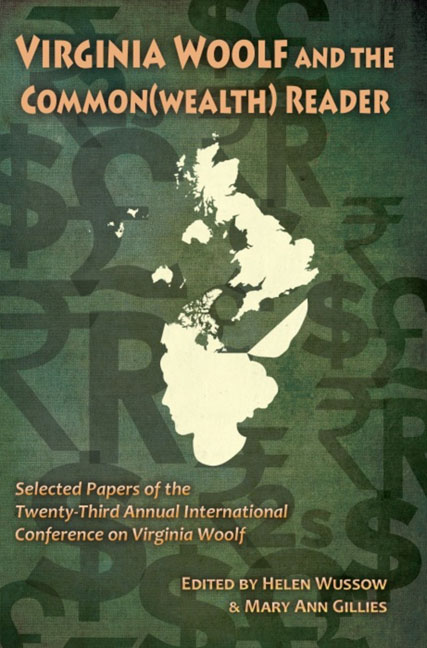Book contents
- Frontmatter
- Contents
- Introduction to Virginia Woolf and the Common(wealth) Reader
- Acknowledgments
- List of Abbreviations
- Invocations
- Networks of Affiliation: Foundations and Friends
- Woolf and the Commonwealth
- “Simplicity and art shades reign supreme”: Costume, Collectibles, and Aspiration in Katherine Mansfield's New Zealand
- Wealth in Common: Gifts, Desire, and Colonial Commodities in Woolf and Mansfield
- On a View from the Rims: Katherine Mansfield and Emily Carr
- London Calling: Una Marson in the Colonial London Scene
- Modernism Across the Commonwealth: Virginia Woolf's and Arundhati Roy's Critique of Empire
- From Bloomsbury to Fountain Lakes: An Australian Virginia Woolf
- 1930s Onwards
- Woolf Beyond the Book
- Notes on Contributors
- Conference Program
From Bloomsbury to Fountain Lakes: An Australian Virginia Woolf
from Woolf and the Commonwealth
- Frontmatter
- Contents
- Introduction to Virginia Woolf and the Common(wealth) Reader
- Acknowledgments
- List of Abbreviations
- Invocations
- Networks of Affiliation: Foundations and Friends
- Woolf and the Commonwealth
- “Simplicity and art shades reign supreme”: Costume, Collectibles, and Aspiration in Katherine Mansfield's New Zealand
- Wealth in Common: Gifts, Desire, and Colonial Commodities in Woolf and Mansfield
- On a View from the Rims: Katherine Mansfield and Emily Carr
- London Calling: Una Marson in the Colonial London Scene
- Modernism Across the Commonwealth: Virginia Woolf's and Arundhati Roy's Critique of Empire
- From Bloomsbury to Fountain Lakes: An Australian Virginia Woolf
- 1930s Onwards
- Woolf Beyond the Book
- Notes on Contributors
- Conference Program
Summary
“I want to effluent, Mum, effluent!”
—Kim to her mother Kath (“Sex”)This quote from the Australian TV show Kath and Kim demonstrates the social position of the title characters as lower or middle class, identified by the desire for affluence but the inability to express this desire in Standard English, separating the members of the former colony of Australia from their former colonizers, the British. Yet, perhaps more importantly, this playful and subversive use of the English language (substituting “effluent” for “affluent”) signifies a critical example of the type of humor the writers, Gina Riley and Jane Turner, are known for. Riley and Turner manipulate the English spoken in Australia into something Australian; in this case, Australian correlates with being crass, challenging British linguistic norms, and using wordplay to create humor.
Within the context of Kath and Kim, language is not the only English element to be manipulated; the writers also take aim at the British emblem of Virginia Woolf. As a cultural figure, Woolf symbolizes England and its global colonial realm; even though her works and biography might be obscure to many, she is a representation of British might and values across the English-speaking world. The Australian sitcom Kath and Kim, in the episode “Kicking up a Stink,” displays several representations of Virginia Woolf (ranging from writer to madwoman to wife) to challenge the British as a post-colonial cultural force in Australia. This episode demonstrates how nationalism is rhetorically constructed through popular culture, appealing to a mass Australian audience because of the ways Australianness counters Britishness. The show subverts the post-colonial hierarchy between Britain and Australia through the creation of a simulacrum. This episode showcases the popular image of Virginia Woolf by converting her into an Australian pop cultural icon, a simulacrum of Australian Virginia Woolf. Gleaning from the theories of Gramscian hegemony, I analyze this text as a piece of popular culture, which touts what I define as Australianness as complicating British hegemonic influence. Woolf's transformation from British to Aussie mimics the transformation of formerly British citizens into Australians; this image articulates the negotiation of white/dominant Australian identity as sometimes between national allegiances and tangled with British hegemony.
- Type
- Chapter
- Information
- Virginia Woolf and the Common(wealth) Reader , pp. 121 - 126Publisher: Liverpool University PressPrint publication year: 2014

